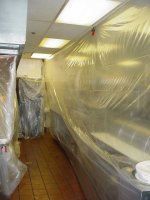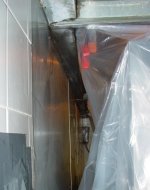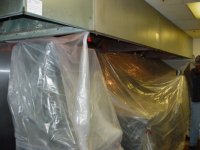You are using an out of date browser. It may not display this or other websites correctly.
You should upgrade or use an alternative browser.
You should upgrade or use an alternative browser.
Curtain system for hoods
- Thread starter max_rob
- Start date
David Saulque
Senior Moderator
Rob
I can tell by your question you need some help. The last thing you want to use is a curtain set up. The best way is to use claps-tape and 1.5m plastic. Some use wooden lath strips and claps.
Curtain set ups can be a major problem-for no other reason than the smell after a few jobs. You will spend more time trying to clean the curtain than it is worth.
David
I can tell by your question you need some help. The last thing you want to use is a curtain set up. The best way is to use claps-tape and 1.5m plastic. Some use wooden lath strips and claps.
Curtain set ups can be a major problem-for no other reason than the smell after a few jobs. You will spend more time trying to clean the curtain than it is worth.
David
max_rob
New member
I was not refering to an actual curtain, it was just what I used to best describe it.
My idea is using a set up with framing that I would drape new plastic for each job, clamping it to the framework. I have sketched out the things I would need for easy tear down and all the right materials. It would be adjustable to fit the different heights of the hoods.
My idea is using a set up with framing that I would drape new plastic for each job, clamping it to the framework. I have sketched out the things I would need for easy tear down and all the right materials. It would be adjustable to fit the different heights of the hoods.
kmjt1021
Member
Yeah
Readjusting is the name of the game. What are you using to catch the water? I have found that the lower the container the better things seem to work, gravity! I will sometime use a small 5-gallon rubber made storage container with a pump in it to keep it from filling up. We are all going to have our own little tricks here that will be hard to explain in the format
Readjusting is the name of the game. What are you using to catch the water? I have found that the lower the container the better things seem to work, gravity! I will sometime use a small 5-gallon rubber made storage container with a pump in it to keep it from filling up. We are all going to have our own little tricks here that will be hard to explain in the format
Dave Olson
Workin North of 60
David Saulque
Senior Moderator
Hood size, equipment setup creates a situation that would prevent any design that would work. Once a design is made you must modify at the next store.
David
David
Dave Olson
Workin North of 60
What David said is why I posted that picture. The time for one of my guys to put up that wall was just a few moments. It protects everything away from the hood canopy. Comes down at the end of the job quick too! Cost is next to nothing for material and we already use the spring clamps in other areas.
Dave Olson
Dave Olson
kmjt1021
Member
I agree with that however
How many of us tuck/JAM the plastic between the wall and the hood to hold it in place? I'm guilty. To be technical that seam should be caulked and we should not disturb that caulking.
With that being said, that method is often the only way.
Now have you seen those bar clamps where the clamp part slides back a forth on the bar, and you can turn the clamps so they either push out or pull in? I was thinking of something along those lines. It would probably be adjustable enough to work, you could use as long a bar as necessary or connect them together. Getting the seal against the wall is the problem, I guess it would have to have a rubber strip on the side of it. A similar material to a squeegee.
The time and effort to make it happen just doesn't seem to be worth it. I sure have thought about it a lot though, maybe I have too much time on my hands.
How many of us tuck/JAM the plastic between the wall and the hood to hold it in place? I'm guilty. To be technical that seam should be caulked and we should not disturb that caulking.
With that being said, that method is often the only way.
Now have you seen those bar clamps where the clamp part slides back a forth on the bar, and you can turn the clamps so they either push out or pull in? I was thinking of something along those lines. It would probably be adjustable enough to work, you could use as long a bar as necessary or connect them together. Getting the seal against the wall is the problem, I guess it would have to have a rubber strip on the side of it. A similar material to a squeegee.
The time and effort to make it happen just doesn't seem to be worth it. I sure have thought about it a lot though, maybe I have too much time on my hands.
Dave Olson
Workin North of 60
Dave Olson
Workin North of 60
Douglas Hicks
Member
I saw the spring clamps used on ceiling tile supports before, but the clamps were bent to the inside so they grabbed the both sides of the tile supports.
Douglas Hicks
Baker County S & R
General Fire Equpment Co of Eastern Oregon, Inc
Douglas Hicks
Baker County S & R
General Fire Equpment Co of Eastern Oregon, Inc
Douglas Hicks
Member
You are right Bryan, the only time I saw the bent spring clamp jaws, it looked like a good way to poke holes in the plastic.
KMJT, we use a clamp similar to what you are asking about. The clamp goes on teh outside perimter, and then we use spring clamps to to clamp the plastic to the clamp yuou mentioned. Benefits are the plastic is above the lower edge of the sheet metal, so the run-off stays in the plastic drape.
Mr Olson, in your picture it looks like are not done draping the hood. We put clamps on the front of the hood, drape the plastic areound the front and then into the trash can.
Douglas Hicks
General Fire Equipment Co of Eastern Oregon, Inc
KMJT, we use a clamp similar to what you are asking about. The clamp goes on teh outside perimter, and then we use spring clamps to to clamp the plastic to the clamp yuou mentioned. Benefits are the plastic is above the lower edge of the sheet metal, so the run-off stays in the plastic drape.
Mr Olson, in your picture it looks like are not done draping the hood. We put clamps on the front of the hood, drape the plastic areound the front and then into the trash can.
Douglas Hicks
General Fire Equipment Co of Eastern Oregon, Inc
Dave Olson
Workin North of 60
Hello Douglas,
Usually my guys will leave the drape as in the photo while the upper stack and fan are being cleaned. When cleaning the plenium on large canopies the front of the hood needs to be open for the technician to get access to this area. Enough plastic drape is left available to raise up to the upper/front part of the hood to help control the water flow into a barrel after the back part is done.
This is why we have the outer wall of plastic to protect anything close to the hood from over spray. We also may need to low pressure spray the exterior of the canopy. The wall helps us mask off the rest of the area.
Dave Olson
Usually my guys will leave the drape as in the photo while the upper stack and fan are being cleaned. When cleaning the plenium on large canopies the front of the hood needs to be open for the technician to get access to this area. Enough plastic drape is left available to raise up to the upper/front part of the hood to help control the water flow into a barrel after the back part is done.
This is why we have the outer wall of plastic to protect anything close to the hood from over spray. We also may need to low pressure spray the exterior of the canopy. The wall helps us mask off the rest of the area.
Dave Olson
kmjt1021
Member
Dave
We can usually set up the plastic so that we catch what come out of the ducts and if need be we can unclamp it from what ever we are using to catch it, fold the plastic it over itself so we can still get to the hood to do what needs to be done, then simply clamp it back and finish washing out the hood. no need to let it get to the floor ever.
We can usually set up the plastic so that we catch what come out of the ducts and if need be we can unclamp it from what ever we are using to catch it, fold the plastic it over itself so we can still get to the hood to do what needs to be done, then simply clamp it back and finish washing out the hood. no need to let it get to the floor ever.




